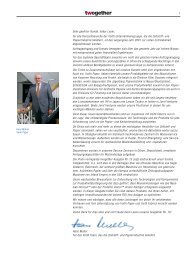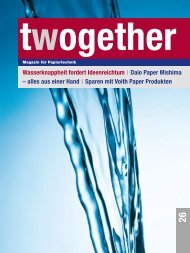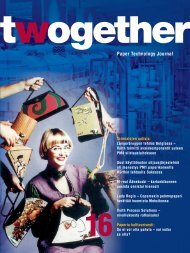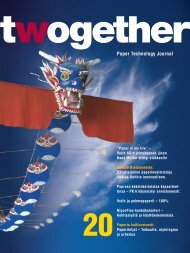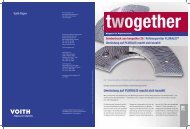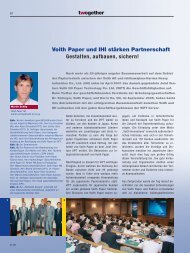Create successful ePaper yourself
Turn your PDF publications into a flip-book with our unique Google optimized e-Paper software.
However, the craft that celebrates this<br />
one thousand five hundred year old legend<br />
is threatened with extinction. In the<br />
craft workshops it is almost always old<br />
people that one sees working the bamboo<br />
skimming screens. Many of the best papermakers,<br />
honoured and promoted by<br />
the government as “living art treasures”,<br />
have already reached the age of 80 or beyond.<br />
So far, the business acumen of a<br />
few enthusiasts has saved this tradition<br />
from vanishing completely, and, at the<br />
moment, Japan is even undergoing a distinct<br />
Washi renaissance.<br />
PA P E R C U LTU RE<br />
Japanese <strong>Paper</strong> Blossoms Anew<br />
Once upon a time there was a beautiful princess … Japanese legends<br />
usually start that way too. The princess descended from heaven and taught<br />
the Japanese people in the Kansai region the art of Washi making. Very soon<br />
it turned out that it was the Goddess of <strong>Paper</strong> herself who had chosen this<br />
method of introducing “Wa Shi” – literally translated “Japanese <strong>Paper</strong>” – to the<br />
world. Until this very day, Washi has remained a legendary paper in the true<br />
sense of the word. It is as much part of the Western world’s traditional image<br />
of Japan as Geisha, Samurai and Harakiri.<br />
Japanese paper is a much soughtafter<br />
product, particularly because of its<br />
high quality. German book illustrator<br />
Veronika Schäpers, who studied the art<br />
of papermaking for some years in Japan,<br />
explains:<br />
“No chemical additives are used in the<br />
production process. In traditional European<br />
rag paper the fibres are short and<br />
thick, whereas in Japanese Washi paper<br />
they are long and thin. The papermakers<br />
can thus produce outstandingly strong,<br />
tear-resistant paper.” In addition, a different<br />
skimming process is used. The<br />
65<br />
fibres are arranged more uniformly in one<br />
direction and the paper’s surface is<br />
smoother.<br />
Top-quality Washi is very popular among<br />
artists, particularly book printers, lithographers<br />
and painters. The Japanese wood<br />
engraver Katsushika Hokusai acquired<br />
world fame with his Washi <strong>Paper</strong> prints<br />
of mount Fuji. The Hamburg artist Horst<br />
Janssen too, whom experts have extolled<br />
as the “Albrecht Dürer of the 20th century”,<br />
also preferred to use high-quality<br />
paper from Japan for his masterpieces.<br />
<strong>17</strong>/04



